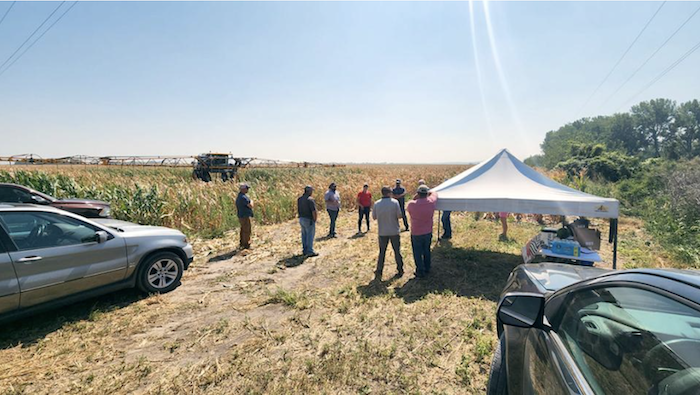Synopsis of Fall 2022 Interseeding Accomplishments
In 2022, a highboy interseeder was utilized to interseed cover crops across 2,972 acres in 33 corn fields throughout Nebraska. Each field received a broadcast application of either cereal rye or a mix of cover crops, including cereal rye, turnips and rapeseed, at an average rate of 70 lb/ac.
Pictured is the Highboy Interseeder that was used in this project.
Fall 2023 Interseeding — Changing the Approach
As we moved into spring 2023, our team noted poor cover crop growth performance for many field sites interseeded during fall 2022. Poor performance was likely attributed to the combined effect of a dry 2022 growing season, following a dry fall and winter. No biomass data was collected during spring 2023.In 2023, building upon the insights gained from the previous year's demonstrations, we collaborated with 24 growers to interseed cover crops across 26 fields, covering approximately 3,400 acres, with a base rate of 70 lb/ac. We implemented several modifications to enhance the effectiveness of the HiCCIP demonstrations.First, we adjusted the interseeding dates based on observations that the early timing of interseeding (fall 2022), when corn was still green and sunlight was mostly intercepted by the canopy, hindered cover crop growth post-germination. In 2023, we started interseeding on Aug. 28, when corn was at R5.5 growth stage. At this stage, corn plants are approaching maturity, and drying leaves allowed more sunlight to reach the soil surface, allowing for better cover crop growth compared to the earlier interseeding dates in 2022.For the 2023 growing season, on-farm research trials were conducted. Figure 2 shows an example of the experimental layout we used for OFR trials. Experimental layout included replicated check strips with no cover crops, alongside various treatment combinations:- Interseeded × check (no cover crops).
- Interseeded × drilled.
- Interseeded × drone interseeded.
- 2x interseeded rate.

Figure 2. Example of a collaborators' field showing fall cereal rye establishment, check strips and on-farm research area.
Fall 2023 Interseeding Preliminary Results
Figure 3 shows preliminary stand counts for 13 fields interseeded during fall 2023. Stand count is presented as a percent (%) of plants emerged, which is the total emerged plants relative to the total number of seed planted. For example, the expected number of cereal rye plants is 34 per square foot at 70 lb/ac, and the counted emerged living plants was 17 plants per square foot, therefore emergence rate is 50% (17÷34). Values ranged from 1% to 84% with an average of 27% emergence rate for the fields interseeded with cereal rye. The emergence rate for the fields interseeded with the cover crop mix ranged from 16% to 77% with an average of 41%.
Figure 3. Emergence rate measured from mid-October to early November for cereal rye and mix of cover crops at fields interseeded during corn growth state R5.5. Black bars are the average among all fields for the cover crop selection.

Figure 4. Cereal rye interseeded on Aug. 30, 2023. This picture was taken on Nov. 11, 2023.
Related Content:
UNL Experiments with Interseeding Cover Crops Using Highboy,
Seeding Practices and Nitrogen Management for Western Nebraska Soybean: What Matters and Why, Fine-Tune No-Till Drills For Better Cover Crop Seeding





